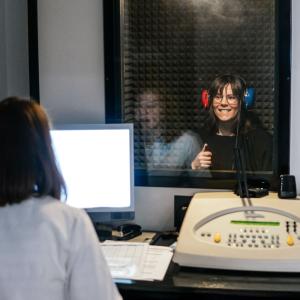For Patients with Severe Hearing Loss, Tuning an Implant Device Just Became Simpler with Artificial Intelligence Software

An experimental AI program could cut the number of readjustment visits for patients requiring cochlear implants in half—and improve outcomes.
Photo: Hoxton/Tom Merton/Getty
In 2015, Susan B. Waltzman, PhD, and colleagues invited a physician–scientist from Belgium to speak at an NYU Langone conference on programming cochlear implants. Dr. Waltzman, co-director of NYU Langone’s Cochlear Implant Center, wanted to hear more about the artificial intelligence (AI)–based software the Belgian group had developed to make the devices easier to tune.
The researchers were struck by what they heard. “We were all impressed by the potential for this technology to dramatically improve programming methods,” says Dr. Waltzman, the Marica F. Vilcek Professor of Otolaryngology—Head and Neck Surgery.
More than 40,000 adults and 25,000 children in the United States have cochlear implants. The device picks up sounds and transmits them as electrical signals to implanted electrodes that stimulate the auditory nerve in the inner ear. Because the damage to the auditory nerve varies from person to person, every cochlear implant must be individually programmed to provide the best outcome. To do that, an audiologist usually tries different settings on the implant, noting the patient’s response. “There hasn’t been a standardized, objective method, and patients may not always end up with the desired result,” Dr. Waltzman says. In addition, patients who receive an implant can return 10 times or more in the first year for adjustments.
To reduce that burden, Dr. Waltzman and colleagues embarked on a multicenter clinical trial of the new AI-based technique. In this study of 100 patients, an AI program ties into the implant to monitor the signals received by the auditory nerve. Based on a large database of information from previous cochlear implant patients, the software knows what the optimal received signals should be to produce the ideal result for a given patient. The AI software autoadjusts the way the implant converts sounds to signals until it achieves the best match.
The trial started in early 2018 and will end in September of 2019. Dr. Waltzman points out that among patients in the trial who previously experienced the conventional implant-tuning procedure, more than three quarters reported preferring the technique. For patients getting a new implant, the new approach has cut the number of required readjustment visits in the first year by more than half.
Dr. Waltzman expects the new process to become widely available late this year, adding that the Cochlear Implant Center is already making it available to patients with cochlear implants outside the trial who have not done as well as expected with their implants. “We’ve been using the same approach for more than 30 years,” she says. “It’s very exciting to be able to offer better outcomes, a better patient experience, and fewer visits to the center.”

